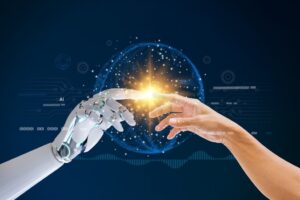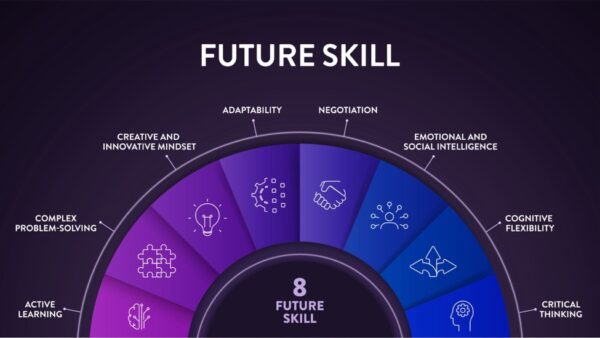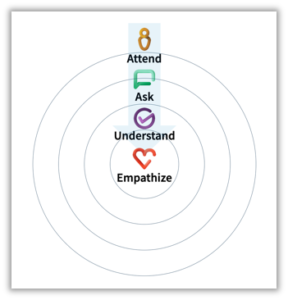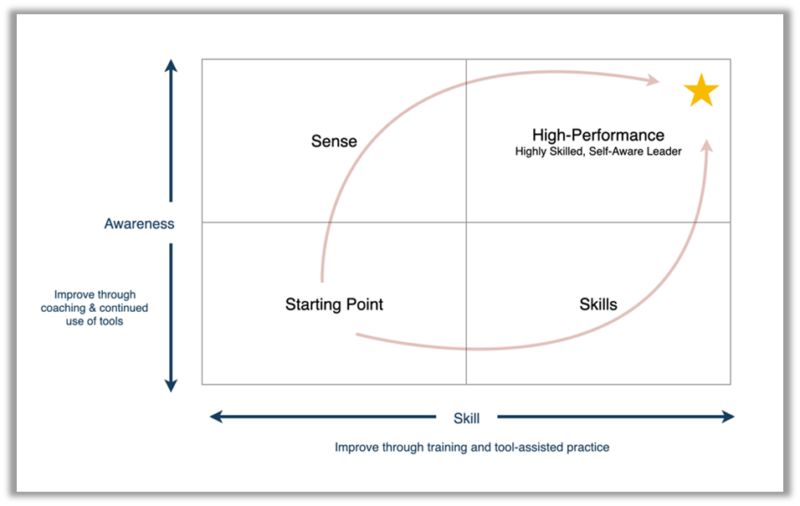Future-Ready Leadership

The Appleton Greene Corporate Training Program (CTP) for Future-Ready Leadership is provided by Mr. Stone Certified Learning Provider (CLP). Program Specifications: Monthly cost USD$2,500.00; Monthly Workshops 6 hours; Monthly Support 4 hours; Program Duration 12 months; Program orders subject to ongoing availability.

Personal Profile
Mr. Stone is an American business leader with a passion for nurturing healthy, high-growth teams powered by direct, open dialogue. He is an irrepressible optimist who believes strongly that in the business of life, we all either win together, or we all lose together.
Mr. Stone is the CEO of BehavioralOS®, a global agency that provides leaders with a proven method developed by an MIT behavioral scientist for proliferating the two most important ingredients for any company’s success: trust and respect. He draws on broad experience over twenty-five years as a business development professional, entrepreneur, and former practicing attorney. He brings a global perspective to all of his engagements, having spent over fifteen years of his life living in Europe and Asia.
Mr. Stone has been a speaker and facilitator on leadership and communication at various events and conferences including the Organization Development Network Conference in the U.S. He has also provided executive facilitation and consulting services in Europe and Asia.
Mr. Stone earned his B.A. in History from the Clark Honors College at the University of Oregon, and his Juris Doctor degree from the William S. Richardson School of Law, University of Hawai’i. He currently lives in the New York City area.
To request further information about Mr. Stone through Appleton Greene, please Click Here.
(CLP) Programs
Appleton Greene corporate training programs are all process-driven. They are used as vehicles to implement tangible business processes within clients’ organizations, together with training, support and facilitation during the use of these processes. Corporate training programs are therefore implemented over a sustainable period of time, that is to say, between 1 year (incorporating 12 monthly workshops), and 4 years (incorporating 48 monthly workshops). Your program information guide will specify how long each program takes to complete. Each monthly workshop takes 6 hours to implement and can be undertaken either on the client’s premises, an Appleton Greene serviced office, or online via the internet. This enables clients to implement each part of their business process, before moving onto the next stage of the program and enables employees to plan their study time around their current work commitments. The result is far greater program benefit, over a more sustainable period of time and a significantly improved return on investment.
Appleton Greene uses standard and bespoke corporate training programs as vessels to transfer business process improvement knowledge into the heart of our clients’ organizations. Each individual program focuses upon the implementation of a specific business process, which enables clients to easily quantify their return on investment. There are hundreds of established Appleton Greene corporate training products now available to clients within customer services, e-business, finance, globalization, human resources, information technology, legal, management, marketing and production. It does not matter whether a client’s employees are located within one office, or an unlimited number of international offices, we can still bring them together to learn and implement specific business processes collectively. Our approach to global localization enables us to provide clients with a truly international service with that all important personal touch. Appleton Greene corporate training programs can be provided virtually or locally and they are all unique in that they individually focus upon a specific business function. All (CLP) programs are implemented over a sustainable period of time, usually between 1-4 years, incorporating 12-48 monthly workshops and professional support is consistently provided during this time by qualified learning providers and where appropriate, by Accredited Consultants.
Executive summary
Future-Ready Leadership
We are at the beginning of yet another technology-driven revolution. Artificial intelligence is disrupting almost every aspect of business and life, including what it takes to be an effective leader.

As this new revolution matures, no one can foresee all the changes that it will bring; but we do know that the changes will be varied, rapid, and profound. Humans have yet again invented new technologies that force humans to adapt at an even faster pace.
As machines get faster at learning, so must humans. The leaders who will succeed in an era of exponential technological advancement will be people who can create and sustain optimal conditions for learning and growth—in themselves, their teams, and their organizations.
Humans have demonstrated over many millennia that when we communicate and collaborate, we adapt and thrive. In the age of exponential technological advancement, with machines now able to learn how to learn, the highest and best use of human capital is to be masters of learning. More than ever, this will require a new type of leadership paradigm, one that is human-centered, powered by effective interpersonal communication and the constant exchange high quality feedback.
One of the great conundrums facing many organizations today is that the communication device most essential to learning and growth—feedback—is the thing that most of us are deathly afraid to exchange.
This course offers a comprehensive experiential learning journey for leaders to become future-ready by reinventing their relationship with feedback and interpersonal communication. This in turn will equip them to lead healthy, high-growth teams capable of adapting at speed and succeeding in a rapidly changing business climate.

Background
As much as the challenges facing modern leaders have changed significantly in the last fifty years, many beliefs and practices have not. Understanding what fuels our underlying assumptions about what makes an effective leader helps us bridge the gap between myth and reality and advance as individuals, businesses, and societies.
With the growth of manufacturing-based industry in the early to mid-20th Century, fueled in part by significant global miliary campaigns, there is little wonder why so much of traditional management philosophy and language is influenced by manufacturing and miliary culture. The top-down, command-and-control management style fits well within this paradigm.
In many workplaces, a leader’s value was judged first and foremost by their subject matter expertise. The vestiges of the 20th Century management live on in business metaphors, leadership quotes, and commonly held beliefs about who should be promoted and how they should motivate the team and conquer the competition. Conditions on the ground are changing, though, and so must we.

By the late 20th Century, the Digital Age was ushering in exponential technological growth that made it easier and cheaper to access information, complete basic tasks, and travel. Plus, as the speed of innovation started to pick up, having teams capable of constant adaptation and innovation became more important. Losing your smartest, most collaborative and creative people in the competition for the best and brightest became a bigger and bigger risk to any company. Many companies that failed to innovate atrophied or even died. One need look no further than Kodak, Blackberry, or Sears.
Many in the leader development world started to realize that top down, power-based leadership, even the benevolent variety, needed to shift to one that could flex to the individual. It was, one might say, a shift to a focus on the Individual—understanding individual differences and helping individuals understand themselves. Much research was sunk into human psychology. The growth in popularity of psychometric tests exemplifies this shift.
Eventually, many began to recognize that focusing on the individual had created a “me” focus that had limitations when it came to helping people work together. Innovation has always, since the dawn of human existence, required a lot of collaboration and interpersonal communication. So there needed to be a shift from focusing on “me” to focusing on “we.”

Current State of Affairs
Staying ‘connected’ is easier than ever, but surving and thriving in this new digital age requires more than mere connection. An organization’s best asset or worst liability is the ability of its people to communicate.
Communicating with our colleagues and coworkers feels like the most natural thing in the world. Yet, doing it effectively is difficult.
Increasingly complex and volatile business markets and supply chains and the rise of remote-working, time, distance, AI and other technologies are combining to make effective interpersonal communication harder than ever. Interacting clearly and in a way that aligns information and audience is challenging, especially in environments shaped by diverse egos, agendas, deadlines, and data.
Though so prevalent it can feel invisible, communication determines not just the internal tenor and culture of an organization, but it’s external performance and success.
Communication is the power on which the engine of every business runs, and feedback loops power the accelerator. Giving and receiving feedback is a form of interpersonal communication that is both essential and uniquely challenging.

Because our understanding of interpersonal communication is internal, we can’t help but assume we know the best way to interact with peers and colleagues. Unfortunately, hundreds of studies, thousands of failed companies, and millions of unhappy workers indicate this is rarely the case.
The truth is, we don’t know what we don’t know and what we don’t know can hold us and those we work with back. This is often revealed in managers who avoid “difficult” conversations and believe being liked is more important than being honest. The result is often a dysfunctional environment defined by employees who feel helpless, and a culture battered by high turnover that is incapable of innovating and adapting at speed.
The answer is to improve trust and communication between people in ways that create high-growth, mutually rewarding relationships with colleagues and all stakeholders.
Many organizations today are laser focused on retaining their best talent. The costs are enormous when the best people leave. Replacement costs, time, threats to information security, and inability to create the collaborative conditions for peak performance are a few.

Source: Zippia.com
Research continually shows that team culture, performance, and retention are directly related to the communication and feedback culture of the team, while at the same time only a minority of managers and direct reports are satisfied with the quality and frequency of feedback exchange.
While most organizations recognize the obvious conundrum, they have difficulty putting into place systems that support and incentivize healthy, high-growth communication and in particular effective feedback loops.
Other technologies have advanced considerably, yet managers today are too often equipped with outdated methods that do not help them manage behavioral quality.
Psychometrics and anonymous 360s are two such examples. Though marginally useful under some circumstances, these legacy solutions are insufficient to meet the moment in many ways. Take personality profiles for example: Knowing one’s “type” can just as easily be used as a sword or shield to avoid personal responsibility as it can to enlighten and build mutual understanding. As for anonymous aggregated 360s, they have been exposed by many studies and personal anecdotes as solutions that often exacerbate the very problems they are deployed to solve. It’s hard enough to take ‘anonymous’ feedback, but when it is focused on vague ‘competencies’ and then aggregated, feedback recipients have a hard time trusting the results, and do not know who specifically needs or wants a particular behavioral change. The process itself can become a vehicle for increasing resentments and distrust.
The limitations of these approaches is in part why coaching has gained in popularity. But at the manager level, individual coaching is often not financially viable.
This course offers an engineering-influenced approach that helps managers both enhance their self-awareness and communication skills while implementing a high-growth behavioral operating system for the benefit of their entire team.
Future Outlook
Learners can expect a journey that helps them develop extraordinary self-awareness and skill to flexibly communicate with, motivate, and develop the unique people they lead. They will understand clearly their values and behavioral preferences and be able to more easily decode others’ values and behavioral drivers. This in turn will help them increase the likelihood that their intent matches desired outcomes. They will be able to build trust, fearlessly seek and speak truth, and drive results while caring for individuals. They will recognize that every behavior has a consequence, and that they are 100% committed to their 50% of every relationship. They will master both the art and science of interpersonal communication. They will be effective human-centered leaders. They will be future-ready.

Alan Mulally is a unicorn who exemplifies this ideal.
When Mulally left Boeing to take over as CEO of Ford Motor Company in 2006, he knew very little about the auto manufacturing business. As an aerospace engineer who had risen the ranks at Boeing, Mulally knew everything there was to know about building, selling, and servicing aircraft. But in his thirty years at Boeing, he had also learned another very important skill – he knew how to engineer a team culture of high performance based on constant collaboration, direct open dialogue, and positive accountability. By the time he left Ford in 2014, it had gone from the brink of bankruptcy to being (at the time) the #1 Auto brand in the United States.
For Mulally, putting people first was more than a platitude, it was a daily priority backed by specific, observable behaviors that he chose with great awareness and intention. When his leadership team at Ford realized that it was safe to be honest about challenges they were facing—including areas where their business units were failing—the team started openly addressing the elephants in the room and working together to solve the problems. Mulally’s ability to get the very best performance from his team was based on mutual respect and building a culture of joyful collaboration. It was a culture that Mulally very much engineered through a combination of conscious choice, genuine care, and fearlessness.
The problem with unicorns, however, is that they are rare. It does not have to be that way.

As we progress ever more swiftly through this era of exponential technological growth, where machines are able to learn certain things faster than humans, we humans must invest in our highest and best use—our humanity—if we are to create more sustainable and future ready companies.
Human-centered leadership is about nurturing high growth by appealing to that which sets human beings apart from machines—creativity, curiosity, artistry, flexibility, sensitivity, vision, courage, and most of all the ability to collaborate to adapt, survive, and thrive.
When humans collaborate to their full potential there are few things out of reach. In some ways, technology has been a great equalizer, giving similar tools to large and small businesses alike. The great differentiator as AI continues to disrupt every aspect of our businesses will be the human decisions that we make along the way. So-called ‘soft skills’ have very hard consequences. If our businesses have ever been in a change-or-die space, this is it.
Becoming future ready as an organization means cultivating a mutually-rewarding, high-growth team culture that embraces individual differences as assets while keeping every person working toward a common goal – constantly growing along the way. The type of healthy friction required to grow necessitates people managers who know how to model norms that make it both ok to make mistakes and unacceptable to remain static when change is necessary.
The future has arrived. The new ‘good-to-great’ model for success is powered by the Human-Centered Leader. There has never been a better time to invest in the mastery of human-centered communication and leadership.
Curriculum
Future-Ready Leadership – Part 1- Year 1
- Part 1 Month 1 Business Case
- Part 1 Month 2 Internal Self-Awareness
- Part 1 Month 3 External Feedback
- Part 1 Month 4 Two-Way Communication
- Part 1 Month 5 Giving Feedback
- Part 1 Month 6 Coaching Conversations
- Part 1 Month 7 Receiving Feedback
- Part 1 Month 8 Behavioral Coding
- Part 1 Month 9 Accelerating Trust
- Part 1 Month 10 Managing Empathy
- Part 1 Month 11 Resolving Conflicts
- Part 1 Month 12 Strengthening Results
Program Objectives
The following list represents the Key Program Objectives (KPO) for the Appleton Greene Future-Ready Leadership corporate training program.
Future-Ready Leadership – Part 1- Year 1
- Part 1 Month 1 Business Case – Get a clear view of the performance-based benefits of mastering human skills and mindset needed to succeed as a leader in the 21st Century. The hard impact of so-called ‘soft skills’ is increasingly apparent. In this module we take a look at the research and topics that differentiate leaders in an era when the ability to communicate with both clarity and sensitivity is the name of the game. This module covers the necessity of practicing self-awareness and developing EQ to progress toward your leadership potential and inspire greatness in others.
- Part 1 Month 2 Internal Self-Awareness – Get clarity about your values and your ‘why’ to strengthen your communication effectiveness and leadership presence. This module will help Learners do a self-examination and find their values, strengths, and the areas for potential growth. Learners finish this module with a clearly articulated statement that captures their growth opportunities for this course.
- Part 1 Month 3 External Feedback – Appreciate the role of external feedback in becoming the leader that you want to be. Learn the role of feedback in communication, and the different types of feedback that are necessary for success in leadership. Identify potential feedback partners for maximum growth potential.
- Part 1 Month 4 Two-Way Communication – Learn a full spectrum of 48 proven behaviors that are specific, actionable, and positive. This push-pull model is a compass for Learners to more easily observe and control their behavioral choices, and gain higher quality insights about the behaviors of others. The resulting real-time awareness positions the Learner to be able to build trust and manage change more efficiently and effectively with a team comprised of unique individuals—each with their own behavioral currency.
- Part 1 Month 5 Giving Feedback – In this module, Learners are introduced to a specific method for reducing fear around feedback, and being able to deliver feedback—including praise—that is clear, constructive, and forward-looking. We will use the “DAP” technique, built on the push-pull model that was introduced earlier to help Learners prepare for and conduct a successful feedback conversation. DAP is a three step method that begins with Describe statements – the factual basis of the feedback, followed by an Appreciate statement – the Givers evaluation of the facts/observation, and then a clear Prescribe – what the Giver would like to see happen in the future.
- Part 1 Month 6 Coaching Conversations – Improve your ability to move with agility and flexibility between different roles as a communicator. This module helps Learners understand the difference between Development through feedback and Coaching—including when each posture is most relevant and useful. Then Learners will dive more deeply into a Coaching Style of communication. We will start with the push-pull model to learn the “Pull Progression” method, then introduce and expand to Powerful Questions.
- Part 1 Month 7 Receiving Feedback – Learning how to both ask for and receive feedback is critical to being a great feedback giver and Leader. In this module, Learners consider their own potential for growth in the area of seeking and receiving. We will cover the reasons for seeking feedback (hint: it makes giving feedback much easier), and will help clarifty methods for setting up the feedback exchange for success. We emphasize the difference between acknowledging and receiving with grace versus agreeing with the premise of the feedback.
- Part 1 Month 8 Behavioral Coding – Learners hone their skills of observation to become confident, clear, and in control of their communication. In this module we will use the behavioral compass introduced earlier to help Learners develop the ability to code (observe) a conversation in real time – improving both awareness and flexibility in both formal and informal meetings and conversations.
- Part 1 Month 9 Accelerating Trust – Trust is indeed the “coin of the realm,” yet it can be highly challenging to build with certain people on a team. In this module, we talk about the behavioral keys to building trust. We focus on how to learn the specific behavioral ‘currency’ of key colleagues to accelerate the trust-building process, particularly early on in a relationship. This module also leverages the push-pull model.
- Part 1 Month 10 Managing Empathy – Learn to overcome the intangible nature of words and phrases like “empathy” and “emotional intelligence” by focusing on the behavioral keys to nurturing the caring side of leadership. We will define empathy, distinguish its meaning from other words like sympathy, and help Learners understand both its usefulness and dangers. We will explore the behavioral mechanics of earning the ability to leverage “caring” as a professional. Everyone is unique, though, so we will turn to the push-pull model again as our compass for adjusting to the unique needs of others.
- Part 1 Month 11 Resolving Conflicts – Build on the techniques learned earlier in this course to improve your ability to help you and your team grow through conflict. We will cover the stages of conflict resolution, and once again turn to the 48 push-pull behaviors as a key resource in both assessing the root causes of interpersonal friction, and creating the conditions for turning separation into a path to connection and ultimately mutual/collective growth. Learners will also have access to a method for reducing ambiguity in times of conflict, giving them more clarity about the willingness of others to commit to a reconciliation process through open dialogue.
- Part 1 Month 12 Strengthening Results – Finally, we build on the premise that the best any of us will ever do is progress, not perfection. This final module provides Learners an opportunity to reflect on their experience through this journey—identifying wins and opportunities for additional investment. We’ll review how Learners’ self-perceptions may have shifted, and challenge Learners to explore the actions not yet taken that could be the most beneficial in the following 90 days. Finally, we will offer additional resources for Learners to apply the behavioral methods and tools to specific moments that matter.
Methodology
Future-Ready Leadership
Program Planning
Planning for this program for Learners begins with learning fundamental principles about self-awareness. We will begin with an introduction of to the importance, role, and steps for cultivating internal self-awareness. After internal self-awareness, we will cover the fundamentals of external self-awareness.
INTERNAL SELF AWARENESS

Improving internal self-awareness is a transformative journey that requires deliberate methodology to cultivate a deeper understanding of one’s thoughts, emotions, values, and motivations. A structured approach to internal self-awareness will include:
Mindfulness Practice: Learners engage in exercises to cultivate present-moment awareness to observe their thoughts and emotions without judgment. Consistent mindfulness fosters a deeper connection to internal experiences, fostering self-awareness.
Journaling/writing: Learners practice recording thoughts, feelings, and experiences. Through journaling, Learners will identify recurring patterns, triggers, and underlying beliefs influencing their behavior. Reflective writing promotes introspection, aiding in the exploration and understanding of their internal landscape.
Emotional Intelligence Development: Learners develop emotional intelligence by recognizing and labeling emotions accurately. Includes practice expressing emotions authentically and empathizing with others’ feelings. Emotional intelligence enhances self-awareness by facilitating a deeper understanding of one’s emotional responses and their underlying drivers.
Self-Reflection: Learners practice structured self-reflection; ask probing questions to explore personal values, strengths, weaknesses, and aspirations. Identify thoughts and patterns in one’s thinking that are self-limiting. Self-reflection fosters introspection, enabling Learners to gain clarity and insight into their identity and purpose.
Values Assessment: Learners sse a multi-step process to identify core values and gain deeper insights into one’s own preferences and tendencies around those values. Then they will learn to translate those values in into relevant business contexts.
Embracing Continuous Learning: Beginning with acceptance of the principle of “progress not perfection,” Learners will engage in activities that challenge existing perspectives, expand knowledge, and promote personal development. Learners will have an opportunity to embrace discomfort as a catalyst for growth, fostering adaptability and resilience in the pursuit of enhanced self-awareness.
By integrating these methodologies into daily practice, Learners will be more prepared to embark on a journey of self-discovery, fostering deeper internal self-awareness and enriching their lives with greater clarity, authenticity, and purpose.

EXTERNAL SELF AWARENESS
Next, Learners will be introduced to the role of external self-awareness in effective communication and growth. It involves developing a keen understanding of how one is perceived by others and how one’s actions impact the external environment. We will cover key methods to enhance external self-awareness, including:
Soliciting Feedback: Learners actively seek feedback from peers, mentors, and supervisors to gain insights into how others perceive your behavior, communication style, and impact on the team and your performance.
Sensing: Learners cultivate empathy by actively listening to others’ perspectives and considering their feelings and experiences. This fosters a deeper understanding of how your actions and words influence those around you.
Observational Learning: Learners observe and learn from others’ behavior, communication styles, and interpersonal dynamics. This provides valuable insights into social cues, norms, and expectations, enhancing your ability to adapt and relate effectively in various situations.
Reflective Practicing: Learners practice reflecting on past interactions, assessing their role, impact, and areas for improvement. Reflective practice fosters self-awareness by prompting critical evaluation of your behavior and its consequences on others.
Learners will identify opportunities to incorporate these methods into daily practice, enhancing their external self-awareness, fostering more effective communication, collaboration, and relationships in personal and professional spheres.
Program Development
The core development step before application begins is learning how to attain extraordinary awareness at a behavioral level. Learners will acquire a proven Push-Pull method for enhancing awareness that consists of 48 specific, observable behaviors, organized in eight distinct Styles – Describe, Prescribe, Appreciate, Inspire, Attend, Ask, Understand, and Empathize. This method accelerates a Learner’s ability to “code” behavior in real time.
Behavioral coding serves as a powerful method for cultivating consciousness of choice by systematically analyzing and categorizing observable behaviors, providing Learners with insight into their decision-making processes and patterns. It is also the key to expanding one’s range of communication flexibility and improving agility.

Here’s how behavioral coding facilitates this process:
Objective Observation: Behavioral coding involves objectively observing and categorizing specific behaviors, such as verbal cues, body language, and actions. By documenting behaviors in a structured manner, Learners gain clarity on their habitual responses and actions in various situations.
Identification of Patterns: Through behavioral coding, patterns and trends in behavior become apparent. Learners can identify recurring behaviors, triggers, and situational factors influencing their choices. Recognizing these patterns enables Learners to become more conscious of the full range of behavioral options and their decision-making processes.
Accountability and Ownership: Behavioral coding promotes accountability and ownership of one’s actions. By documenting and analyzing behaviors, Learners take responsibility for their choices and their consequences, fostering a sense of agency and empowerment.
Feedback and Reflection: Behavioral coding encourages feedback and reflection on observed behaviors. By reviewing coded data, Learners gain insights from external perspectives and self-reflection, deepening their understanding of their choices and motivations.
Intervention and Change: Equipped with insights from behavioral coding skills, Learners can implement targeted interventions to modify their behaviors and decision-making processes. Whether through cognitive restructuring, behavior modification techniques, or mindfulness practices, Learners can proactively work towards aligning their choices with their values and goals.
Continuous Improvement: Behavioral coding supports continuous improvement by providing a structured framework for self-assessment and growth. Through ongoing observation, analysis, and adjustment of behaviors, Learners will achieve greater consciousness of choice and enhance their decision-making efficacy over time.
In summary, behavioral coding serves as a method for cultivating consciousness of choice by promoting objective observation, identification of patterns, accountability, feedback, intervention, and continuous improvement. By leveraging this approach, Learners can gain deeper insight into their decision-making processes and empower themselves to make more intentional and aligned choices in various aspects of life.

Program Implementation
The chief catalyst for implementing the program will be through the planning, practice, and review of feedback conversations.
There are two types of processes, giving and receiving. In this course giving feedback is labeled as conducting an effective “feedback conversation.” The combination of the behavioral model and feedback methodology are the foundation of all program implementation elements.
GIVING
Learners will walk through the first three (of four) stages for successfully giving feedback, which we will label “conducting a feedback conversation.” These three stages are: Initiating, Formulating, and Exchanging. The fourth stage, “Evaluating,” will be covered at the end of the program.
Initiating is the thoughtful process of choosing the time, place, and context in which to conduct the conversation. As the saying goes, “timing is everything.” This is as true for feedback conversations as anything else.
Formulating is about organizing the structure of the information to ensure that the other person receives the message as it is intended and walks away with clarity about what happened, what the other person thinks about it, and what they can or should do in the future. Learners will practice organizing the feedback using a method derived from the behavior model previously introduced in the course called “DAP.” This method entails organizing the feedback into three categories, namely Describe (observable facts), Appreciate (valuation of facts), and Prescribe (what could or should happen in the future).
Exchanging is how Learners increase clarity of purpose by identifying (and differentiating between) Task and Learning Objectives.
Learners will apply the above-references method and parts thereof in various contexts such as conducting coaching conversations and conflict resolution.

RECEIVING
Turning back to external self-awareness, Learners will implement a feedback method that puts them in the Receiver role. This serves the purpose of advancing both communication skill and self-awareness, simultaneously. Learners will attain clarity about the impact of their behaviors with individual colleagues. In this context, Learners will be able to judge their ability to empathize with different types of people while maintain healthy boundaries. This kind of EQ management is critical to Human-Centered Leadership.
Program Review
Finally, Learners will strengthen the results of the training. This involves a systematic approach to gather insights, assess effectiveness, and make informed adjustments.
The method to achieve this includes conducting a comprehensive evaluation to assess the impact of the training on Learners’ knowledge, skills, and behaviors. We will use a combination of quantitative data, such as pre- and post-training assessments, and qualitative feedback through surveys or interviews.
Next Learners will share their experiences, challenges, and insights gained from the experience. Open dialogue and peer learning is encouraged to deepen understanding and reinforce key concepts.
Another key method here is to establish future feedback loops between Learners and key stakeholders to foster continuous improvement, tied to specific, relevant goals.
Learners will practice identifying trends, patterns, and areas of strength or improvement as part of the action planning. They will collaborate with stakeholders to develop action plans based on feedback and evaluation findings, prioritizing further growth opportunities with the greatest impact on achieving desired outcomes.
By following these methods, Learners will strengthen the results of the training course and gain both confidence and clarity as they communicate their way to success.

Industries
This service is primarily available to the following industry sectors:

Government
The government sector in the United States has experienced significant shifts in recent history, with evolving priorities, technological advancements, and political dynamics shaping its trajectory. A brief examination of its recent history, current trends, and future outlook provides insight into the challenges and opportunities facing this vital sector.
In recent decades, the government sector has undergone notable changes in response to shifting political landscapes and societal needs. The early 21st century saw the aftermath of the September 11th terrorist attacks, leading to increased focus on national security and the expansion of government surveillance and intelligence agencies. The mid-2000s witnessed the implementation of landmark legislation such as the Affordable Care Act (ACA), which aimed to expand access to healthcare and regulate the health insurance industry. The Great Recession of 2008 prompted significant government intervention in the form of stimulus packages and bailouts to stabilize the economy and mitigate the impacts of the financial crisis. The 2010s were characterized by heightened political polarization and debates over issues such as immigration, healthcare reform, and climate change, culminating in significant policy shifts with each change in administration.
More recently, several key trends are shaping the government sector in the U.S. One notable trend is the increasing digitization of government services, with agencies leveraging technology to improve efficiency, transparency, and accessibility. Initiatives such as cloud computing, data analytics, and e-government platforms are streamlining processes and enhancing citizen engagement. Another trend is the growing emphasis on cybersecurity and data privacy, as governments seek to safeguard sensitive information and protect against cyber threats. The COVID-19 pandemic has accelerated digital transformation efforts, leading to increased adoption of telework, online learning, and virtual service delivery across all levels of government. Additionally, there is a renewed focus on diversity, equity, and inclusion within the government workforce, as agencies strive to reflect the diversity of the population they serve and address systemic inequalities.
Looking ahead, the future of the government sector in the U.S. is likely to be shaped by a combination of continuity and change. Technological innovation will continue to drive transformation within government agencies, with advancements in areas such as artificial intelligence, blockchain, and automation reshaping service delivery and administrative processes. However, the sector will also face challenges such as aging infrastructure, budget constraints, and workforce shortages, which may hinder progress and require creative solutions. Moreover, the political landscape will continue to influence policy priorities and decision-making, with debates over issues such as healthcare, immigration, climate change, and fiscal policy shaping the direction of government initiatives. Efforts to address systemic inequalities and promote social justice are likely to gain momentum, with calls for reforms in areas such as criminal justice, education, and economic opportunity. Overall, the future of the government sector in the U.S. will be characterized by a mix of innovation, adaptation, and resilience as it seeks to meet the evolving needs of a diverse and dynamic society.

Technology
The technology industry in the United States has undergone remarkable growth and transformation in recent years, fueled by innovation, entrepreneurship, and technological advancements.
Over the past few decades, the tech industry in the U.S. has experienced exponential growth, reshaping the global economy and revolutionizing various sectors. The rise of Silicon Valley in the 1970s and 1980s marked the beginning of a new era of innovation, with pioneers like Intel, Apple, and Microsoft laying the groundwork for the digital revolution. The 1990s witnessed the emergence of the internet and the dot-com boom, propelling companies like Amazon, Google, and eBay to prominence and transforming the way people communicate, shop, and work. The early 2000s saw the rise of social media platforms like Facebook and Twitter, while the late 2000s and 2010s saw the advent of smartphones, cloud computing, and artificial intelligence, further accelerating technological innovation and disruption across industries.
Today, several key trends are shaping the tech industry in the U.S. One notable trend is the increasing convergence of technology with other sectors such as healthcare, finance, and transportation, leading to the emergence of new hybrid industries and business models. For example, the rise of telemedicine and digital health platforms has transformed the healthcare landscape, while fintech startups are revolutionizing the way people access financial services. Another trend is the growing importance of data privacy and cybersecurity, as concerns about online privacy and data breaches continue to escalate. Companies are investing heavily in cybersecurity measures and compliance efforts to protect consumer data and mitigate risks. Additionally, there is a growing emphasis on sustainability and social responsibility within the tech industry, with companies prioritizing initiatives to reduce carbon emissions, promote diversity and inclusion, and address social inequalities. Finally, the COVID-19 pandemic has accelerated digital transformation initiatives across industries, leading to increased demand for remote work solutions, e-commerce platforms, and digital collaboration tools.
The future of the tech industry in the U.S. appears promising, albeit with some challenges and uncertainties. One potential area of growth is in emerging technologies such as artificial intelligence, blockchain, and quantum computing, which have the potential to revolutionize various industries and create new opportunities for innovation and disruption. Moreover, the increasing digitization of the economy is expected to continue, with sectors like healthcare, education, and government embracing technology to improve efficiency, accessibility, and affordability. However, the tech industry also faces significant challenges, including regulatory scrutiny, geopolitical tensions, and ethical concerns surrounding the use of technology. Issues such as antitrust enforcement, data privacy regulation, and the ethical use of AI are likely to remain contentious topics in the years to come. Additionally, the tech industry must grapple with issues of workforce diversity, equity, and inclusion, as efforts to address systemic inequalities and promote social responsibility gain momentum. Overall, the future of the tech industry in the U.S. is likely to be characterized by continued innovation, disruption, and transformation, as companies strive to harness the power of technology to drive economic growth and address pressing global challenges.

Healthcare
The healthcare industry in the U.S. has undergone significant changes in recent years, driven by technological advancements, regulatory reforms, and demographic shifts. A brief recent history provides context for understanding these changes, while current trends offer insights into the industry’s present state, and a future outlook highlights potential developments and challenges on the horizon.
In the past few decades, the healthcare industry in the U.S. has experienced rapid evolution, characterized by rising costs, changing demographics, and advancements in medical technology. The implementation of Medicare and Medicaid in the 1960s expanded access to healthcare for millions of Americans, while the passage of the Affordable Care Act (ACA) in 2010 aimed to further increase coverage and improve affordability. The 21st century has seen significant technological innovation, with the rise of electronic health records (EHRs), telemedicine, and personalized medicine transforming the way healthcare is delivered and managed.
Several key trends are shaping the healthcare industry in the U.S. today. One notable trend is the increasing emphasis on value-based care and population health management, as healthcare providers and payers shift from fee-for-service models to payment models that reward quality, outcomes, and efficiency. This trend is driving greater collaboration and coordination among healthcare stakeholders, as well as investments in data analytics, care coordination, and preventive care initiatives. Another trend is the rise of digital health technologies, including wearable devices, mobile apps, and remote monitoring tools, which are empowering patients to take a more active role in managing their health and wellness. These technologies also hold promise for improving healthcare access and reducing costs by enabling virtual consultations, remote patient monitoring, and telemedicine services. Additionally, there is a growing focus on addressing social determinants of health, such as income, education, and housing, which play a significant role in shaping health outcomes. Healthcare providers and payers are increasingly recognizing the importance of addressing these social factors to improve health equity and reduce disparities among underserved populations.
Looking ahead, the future of the healthcare industry in the U.S. is likely to be shaped by several key drivers and trends. One potential area of growth is in digital health and telemedicine, as advancements in technology enable new models of care delivery and remote patient monitoring. The COVID-19 pandemic has accelerated the adoption of telehealth services, highlighting the potential for virtual care to improve access, convenience, and affordability. Additionally, the rise of artificial intelligence (AI) and machine learning is expected to revolutionize healthcare by enabling predictive analytics, personalized treatment recommendations, and more efficient clinical workflows. However, the healthcare industry also faces significant challenges and uncertainties, including rising healthcare costs, workforce shortages, and regulatory reforms. Issues such as drug pricing, healthcare disparities, and healthcare infrastructure investment are likely to remain contentious topics in the years to come. Overall, the future of the healthcare industry in the U.S. will be characterized by continued innovation, collaboration, and adaptation, as stakeholders work to address the evolving needs and expectations of patients, providers, and payers.
Locations
This service is primarily available within the following locations:

New York, NY
Over the past two decades, New York City’s commercial landscape has evolved significantly due to globalization, technological innovation, and demographic shifts, solidifying its position as a global economic powerhouse. Following the September 11th attacks, the city rebounded, focusing on revitalizing Lower Manhattan and bolstering security measures. By the mid-2000s, the commercial real estate market flourished, marked by iconic skyscrapers like the Freedom Tower and rapid gentrification in neighborhoods such as Chelsea and the Meatpacking District, attracting tech startups and creative industries.
Despite the 2008 financial crisis, New York City’s diversified economy and robust regulatory framework allowed it to weather the storm better than many regions. The city’s financial sector rebounded post-crisis, with new regulations driving innovation in fintech and alternative finance, solidifying its status as a global financial capital. The 2010s witnessed the rise of Silicon Alley as a major tech hub, attracting tech giants like Google, Facebook, and Amazon. Additionally, the retail landscape transformed with e-commerce and the rise of experiential retail concepts.
The last decade saw a renewed focus on sustainability and urban resilience, with investments in infrastructure projects like the High Line and the Second Avenue Subway. This period underscores New York City’s resilience, innovation, and adaptation to 21st-century challenges.
Currently, New York City stands as a hub of finance, technology, media, and culture despite challenges like the COVID-19 pandemic and economic shifts. Wall Street remains a global capital market epicenter, while Silicon Alley continues to thrive, attracting talent and fostering innovation. Media and entertainment industries flourish, drawing millions of visitors yearly. Diverse neighborhoods like Brooklyn, Queens, and Harlem contribute to the city’s commercial vibrancy, fostering creativity and collaboration.
Looking ahead, New York City’s commercial future appears promising. Its magnetism for talent and innovation, diverse economy, and cultural richness position it for continued growth. The finance sector is expected to remain dominant, with opportunities in fintech and sustainable finance. Similarly, the technology sector is poised for expansion, driving innovation in areas like AI, e-commerce, and digital media. Efforts to address challenges like climate change and infrastructure investment will further enhance the city’s sustainability, resilience, and desirability as a place to live, work, and invest.
In summary, New York City’s commercial future outlook is bright, driven by innovation, collaboration, and adaptation to 21st-century challenges. As it continues to evolve, the city reaffirms its status as a global economic powerhouse and cultural icon.

Washington, DC
The Washington DC area, encompassing the District of Columbia and parts of Maryland and Virginia, has a unique economic landscape shaped by its status as the nation’s capital, its diverse industry sectors, and its proximity to federal government agencies and institutions. A brief overview of its recent economic history, current trends, and future outlook provides insight into the region’s dynamic economy.
Recent Economic History: In recent decades, the Washington DC area has experienced steady economic growth, driven primarily by the presence of the federal government and related industries such as professional services, defense contracting, and technology. The late 20th and early 21st centuries saw significant expansion in government spending, particularly in the aftermath of the September 11th terrorist attacks and during the wars in Iraq and Afghanistan. This led to a boom in contracting opportunities for defense and security firms, as well as increased demand for support services such as consulting, legal, and accounting services.
Additionally, the region has seen growth in sectors such as healthcare, education, and hospitality, fueled by its growing population and status as a global destination for tourism and conventions. The development of suburban areas in Maryland and Virginia, along with investments in transportation infrastructure like the Metro system, has facilitated the region’s economic expansion and contributed to its overall prosperity.
Current Economic Trends: In recent years, the Washington DC area has faced economic challenges and opportunities shaped by changing political dynamics, technological advancements, and global trends. The region has seen a shift in government spending priorities, with defense spending plateauing and discretionary spending facing budget constraints. This has led to increased competition among government contractors and a diversification of the regional economy beyond federal government dependence.
Furthermore, the DC area has emerged as a hub for technology startups and innovation, driven by the presence of research institutions, universities, and federal research funding. The rise of the cybersecurity sector, in particular, has spurred growth in the region’s technology ecosystem, attracting investment and talent from around the country and the world.
Future Economic Outlook: Looking ahead, the economic outlook for the Washington DC area is characterized by both opportunities and challenges. On one hand, the region’s diverse economy and skilled workforce position it well to weather economic fluctuations and adapt to changing market conditions. Continued investment in technology, healthcare, and education is expected to drive innovation and create new economic opportunities, while infrastructure projects like the expansion of the Metro system and investments in affordable housing aim to address longstanding challenges related to transportation and affordability.
However, the region faces risks associated with its dependence on federal government spending and the potential for budget cuts or fiscal austerity measures. Political gridlock and uncertainty at the federal level could impact government contractors and related industries, leading to job losses and economic contraction. Additionally, the DC area must grapple with issues of income inequality, housing affordability, and workforce development to ensure that economic growth is inclusive and sustainable for all residents.
In conclusion, the economic history, current trends, and future outlook for the Washington DC area reflect its unique position as the nation’s capital and a hub of government activity, innovation, and diversity. By leveraging its strengths and addressing its challenges, the region is well-positioned to continue driving economic growth and prosperity in the years to come.

Los Angeles, CA
Los Angeles, California, renowned for its entertainment industry, cultural diversity, and vibrant economy, has experienced significant economic growth and transformation in recent years. A review of its recent economic history, current trends, and future outlook offers insights into the region’s dynamic economic landscape.
Recent Economic History: In the late 20th and early 21st centuries, Los Angeles underwent a period of economic revitalization and diversification, fueled by the expansion of its entertainment, technology, and healthcare sectors. The entertainment industry, centered around Hollywood, has long been a cornerstone of the region’s economy, driving job creation, tourism, and investment. Moreover, the emergence of Silicon Beach, a cluster of tech companies and startups in West Los Angeles and Santa Monica, has bolstered the region’s reputation as a hub for innovation and entrepreneurship.
Additionally, the healthcare and biotechnology sectors have experienced significant growth, driven by the presence of leading research institutions, medical centers, and biotech firms. The expansion of the Port of Los Angeles, one of the busiest seaports in the world, has further stimulated economic activity, supporting trade, logistics, and manufacturing industries throughout the region.
In recent years, several key economic trends have shaped the Los Angeles area. The entertainment industry continues to thrive, with streaming services like Netflix and Disney+ investing heavily in content production and distribution. Furthermore, the rise of digital media platforms and the proliferation of streaming services have transformed the way people consume entertainment, creating new opportunities for content creators, advertisers, and tech companies.
Los Angeles has emerged as a leader in sustainable technology and green innovation, with initiatives aimed at addressing climate change and promoting renewable energy. The city’s commitment to sustainability, coupled with investments in clean technology and green infrastructure, has positioned it as a global leader in the transition to a low-carbon economy.
Looking ahead, the economic outlook for the Los Angeles area is characterized by optimism and growth potential. The region’s diverse economy, skilled workforce, and entrepreneurial spirit bode well for continued economic expansion and innovation. The entertainment industry is expected to remain a driving force, with new opportunities emerging in digital media, virtual reality, and augmented reality.
Additionally, the technology sector is poised for further growth, fueled by the expansion of Silicon Beach and investments in artificial intelligence, cybersecurity, and e-commerce. The healthcare and biotechnology sectors are also expected to continue expanding, driven by advancements in medical research, personalized medicine, and telehealth.
Furthermore, Los Angeles’ position as a global gateway and cultural capital provides a competitive advantage in attracting talent, investment, and tourism from around the world. However, the region faces challenges related to housing affordability, transportation infrastructure, and income inequality, which must be addressed to ensure that economic growth is inclusive and sustainable for all residents.
In conclusion, the recent economic history, current trends, and future outlook for the Los Angeles area reflect its dynamic and diverse economy, driven by innovation, creativity, and entrepreneurship. By leveraging its strengths and addressing its challenges, the region is well-positioned to continue thriving as a leading economic powerhouse and cultural icon on the global stage.

Seattle, WA
The Seattle, Washington area has experienced significant economic growth and transformation in recent years, driven by its vibrant technology sector, diverse economy, and strategic location in the Pacific Northwest. A review of its recent economic history, current trends, and future outlook provides valuable insights into the region’s dynamic economic landscape.
Recent Economic History: In the late 20th and early 21st centuries, Seattle underwent a remarkable economic transformation, evolving from a primarily resource-based economy to a hub of technology, innovation, and global trade. The emergence of companies like Microsoft, Amazon, and Boeing propelled the region’s economy to new heights, creating jobs, attracting talent, and driving investment.
Microsoft, founded in 1975, played a pivotal role in establishing Seattle as a technology powerhouse, pioneering the development of personal computing software and laying the foundation for the region’s thriving tech ecosystem. Amazon, founded in 1994, revolutionized e-commerce and cloud computing, further solidifying Seattle’s reputation as a center of innovation and entrepreneurship.
Additionally, Boeing, one of the world’s largest aerospace manufacturers, has been a cornerstone of the Seattle area’s economy for over a century, driving advancements in aviation and aerospace technology and supporting a vast network of suppliers and service providers.
In recent years, several key economic trends have shaped the Seattle area. The technology sector continues to drive economic growth, with companies like Amazon, Microsoft, and a growing number of startups fueling innovation and creating high-paying jobs. Seattle’s thriving tech ecosystem has attracted talent from around the world and spurred investments in research and development, infrastructure, and urban development.
Moreover, the Seattle area has emerged as a leader in sustainability and environmental stewardship, with initiatives aimed at reducing carbon emissions, promoting renewable energy, and addressing climate change. The region’s commitment to sustainability, coupled with investments in clean technology and green infrastructure, has positioned it as a global leader in the transition to a low-carbon economy.
Looking ahead, the economic outlook for the Seattle area is characterized by optimism and growth potential. The region’s strong technology sector, skilled workforce, and culture of innovation bode well for continued economic expansion and prosperity. Companies like Amazon and Microsoft are expected to remain at the forefront of technological advancements, driving growth in areas such as artificial intelligence, cloud computing, and digital transformation.
Additionally, Seattle’s strategic location on the Pacific Rim positions it as a gateway to global markets, providing opportunities for trade, investment, and collaboration with Asia and beyond. The region’s diverse economy, encompassing industries such as aerospace, healthcare, and retail, further enhances its resilience and competitiveness in the global economy.
The Seattle area faces challenges, though, related to housing affordability, transportation infrastructure, and income inequality, which must be addressed to ensure that economic growth is inclusive and sustainable for all residents. By leveraging its strengths and embracing innovation, the Seattle area is well-positioned to continue thriving as a leading center of technology, commerce, and culture in the 21st century.
Program Benefits
Management
- Empathy
- Adaptability
- Communication
- Engagement
- Trust-building
- Conflict resolution
- Coaching skills
- Decision-making
- Team alignment
- Resilience
Human Resources
- Talent retention
- Cultural alignment
- Employee satisfaction
- Leadership development
- Enhanced engagement
- Diversity inclusion
- Conflict resolution
- Performance improvement
- Succession planning
- Workplace well-being
Information Technology
- Enhanced collaboration
- Adaptive problem-solving
- Innovation mindset
- Empowered teams
- Agile project management
- Improved communication
- Talent retention
- Leadership development
- Increased productivity
- Enhanced morale
Testimonials

United States Department of Defense
“I was given the privilege of working through the BehavioralOS program. With the help of an insightful coach who was with me on every step of the journey, I learned that the elements of a behavioral model that was both comprehensive and tangible—without oversimplifying the complexities of human interactions, it gave me real-world tools to understand, and grow, the relationships that matter most.
Having worked through the program with three of my most valued colleagues, I learned what was important to them in our relationship. I also began to develop a feel for how to apply this model and these thoughtful techniques more broadly and more enduringly. I believe I have internalized these lessons to the point where they are now a part of my leadership approach—an approach that is now more individual-focused and more effective. The BehavioralOS method was the single most helpful training of my professional life, and I recommend it to any executive who wants to achieve the self-awareness that is the hallmark of a true leader. “

Dell Technologies
“If you’re the type of leader who gets net promoter scores or satisfaction surveys, and your score keeps going up but your culture keeps going down, you need BehavioralOS.
If you keep getting better scores, but people are leaving your organization, if you’re getting better aggregated results, but people are unhappy on the job, then you need to start using tools that actually speak to fixing the problem and not just masking it with, you know, higher NPS scores and satisfaction scores because people know that if they don’t say that the environment is good, that somebody is going to track them down and figure out that it was that.
[About DE&I]Conversations around race, gender, ethnicity, and identity are very tough to have. So rather than having the conversation around whether or not I’m allowed to show up as a black man, and you’re allowed to show up as a white man or white woman or a black woman, or Hispanic, or transgender, rather than having that conversation— which not a lot of people are well versed in—you can use the BehavioralOS method to have the conversation around the behaviors, and then slowly but surely evolve into the conversations around DE&I.”

Truman Medical Centers
“I started using the BehavioralOS training and tools almost 20 years ago and am convinced, more than ever, that it is the most effective methodology for improving communication and win-win relationships.
Organizations recognize (or should) that effective communication and interpersonal relationships have a direct impact on organizational success. This is particularly critical when it comes to giving and receiving feedback.
While I was Director of Organizational Development at Carondelet Health, BehavioralOS worked closely with us over several years to improve both communication and leadership, and to create a healthier culture.”

Morunda K.K.
“We were changing, we didn’t want to work the way that we had worked. What got us to where we were was not going to get us to the next level, and we knew if we wanted to have a long-term sustainable business that is firm and enjoyable, we needed to flip the whole thing on its head.
We brought in Matt Stone and his team at BehavioralOS to work with our leadership team.
I think because of the training and tools, and because of the changes that we’ve made, we have big fans inside the company. We don’t just have employees, we have rabid fans. It is not uncommon now for people to say, “I love Morunda.””

Auckland Regional Council
“BehavioralOS provided a program for all senior staff to learn the techniques of clear and open communication. As a result, senior staff were able to identify and commit to a major program of change. Structural changes in the ways staff responded to political influence were introduced, with some politicians reacting to a loss of day-to-day control over engineering projects. While its implementation took several months, the initial change cost of $1.4 million resulted in combined savings of more than $30 million in the first year.”
More detailed achievements, references and testimonials are confidentially available to clients upon request.
Client Telephone Conference (CTC)
If you have any questions or if you would like to arrange a Client Telephone Conference (CTC) to discuss this particular Unique Consulting Service Proposition (UCSP) in more detail, please CLICK HERE.











